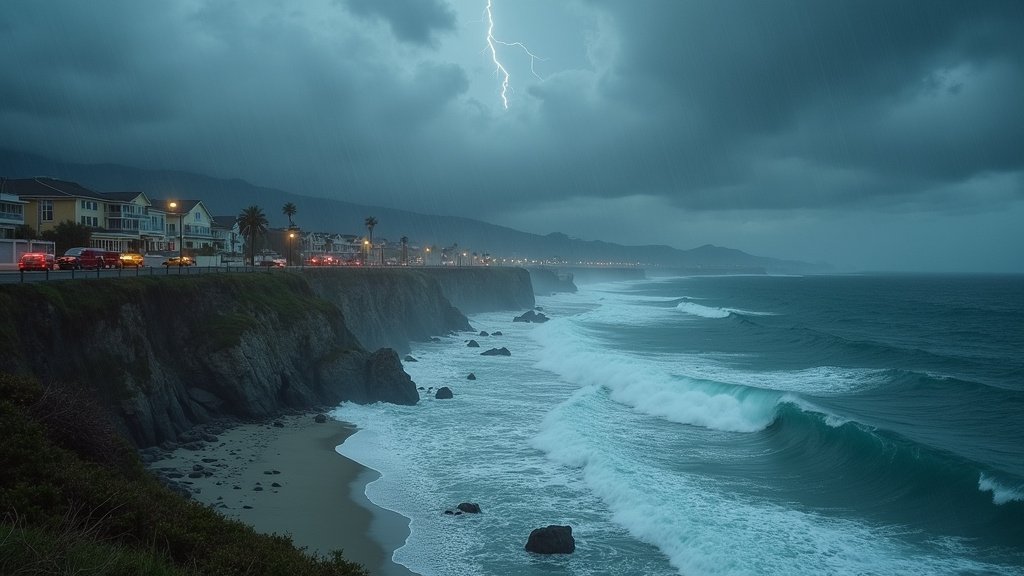California Grapples with Severe Weather as Rain, Rockslides, and Flooding Batter the Region
Southern California is once again under siege, as heavy rainfall continues to lash the region, bringing with it a familiar set of challenges: rockslides and flooding. The relentless downpour is adding to the woes of a state still reeling from the aftereffects of Tropical Storm Hilary, creating a sense of urgency as residents brace for further impacts.
The current weather situation is particularly concerning. The National Weather Service has issued warnings across much of the state, highlighting the potential for widespread disruption. A bomb cyclone and an atmospheric river are developing in the Pacific Ocean, promising to deliver even more moisture and exacerbating the already precarious conditions. This potent combination of weather systems has the potential to unleash devastating consequences, including further mudslides, infrastructure damage, and displacement.
The immediate focus is on mitigating the damage and ensuring the safety of residents. Emergency services are on high alert, monitoring vulnerable areas and preparing for potential rescues. Authorities have urged residents in flood-prone zones and areas susceptible to rockslides to take necessary precautions, including heeding evacuation orders and securing their properties.
The Lingering Aftermath of Tropical Storm Hilary and the Long-Term Climate Threat
The latest bout of severe weather serves as a stark reminder of the challenges facing California, particularly in the wake of Tropical Storm Hilary. The storm, which struck earlier this year, caused significant damage and disruption across a wide swath of the state. The recovery process is ongoing, and the new weather event is set to further complicate matters.
The continuous cycle of extreme weather events, from the damaging effects of Hilary to the current deluge, highlights the state’s vulnerability to climate change. Beyond the immediate threats of flooding and rockslides, the long-term consequences of a warming planet are looming large. One particularly alarming study predicts a potentially devastating future for California’s iconic coastline.
Coastal Erosion and the Threat to California’s Beaches
Beyond the immediate dangers of the current storm systems, a recent study paints a grim picture of the future of California’s coastline. Projections suggest that the state could lose more than half of its beaches by the year 2100 if current climate trends continue unabated. This is a truly sobering assessment, with potentially catastrophic implications for the state’s economy, environment, and way of life.
The loss of beaches would not only impact tourism and recreation but would also leave coastal communities more vulnerable to storm surges and erosion. This poses a significant threat to infrastructure, property values, and the overall health of coastal ecosystems. The findings of this study underscore the urgent need for decisive action to address climate change and protect California’s precious coastline.
San Jose Police Arrest Four in Connection with Suspected Gang-Motivated Attack
While the state grapples with the effects of severe weather and the looming threat of climate change, law enforcement agencies are also dealing with pressing issues on the ground. In a separate but related development, the San Jose police have announced the arrest of four individuals in connection with a suspected gang-motivated attack.
Details surrounding the attack are still emerging, but the arrests represent a significant step in the investigation. The San Jose Police Department is committed to maintaining public safety and combating gang violence, which is a persistent challenge in many communities. The incident underscores the multifaceted nature of the problems facing California, where law enforcement must respond not only to natural disasters but also to human-caused threats.
Looking Ahead: Preparedness and Resilience
As California confronts these challenges, the focus is shifting towards building greater resilience and preparedness. This involves strengthening infrastructure, developing early warning systems, and implementing proactive measures to mitigate the impacts of extreme weather events. The state is also investing in climate change adaptation strategies, including measures to protect coastal communities and reduce greenhouse gas emissions.
The situation in California serves as a stark reminder of the interconnectedness of environmental, social, and economic challenges. The state’s response to the current weather events, along with its efforts to address climate change and combat crime, will shape its future for years to come. The coming days and weeks will be crucial as the state navigates these complex issues and works to ensure the safety and well-being of its residents.


















